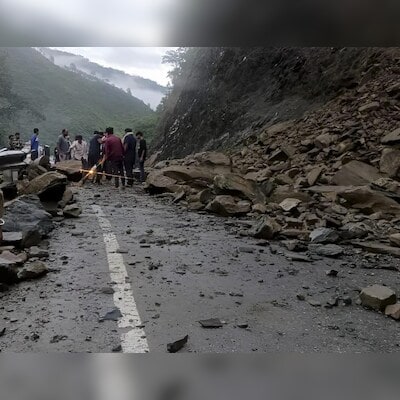A massive landslide hit eastern Sikkim on Tuesday, damaging parts of a 510 MW hydroelectric project on the Teesta river | (Photo: PTI)
In the wake of the landslides in Sikkim, the Congress on Wednesday attacked the government, saying that hydroelectric projects have come up in ecologically fragile regions in recent years without adequately thinking about their cumulative environmental impact.
The opposition party also said that the dams on the Teesta river are the prime example of how the ecology is being fundamentally altered with serious consequences for this and future generations.
A massive landslide hit eastern Sikkim on Tuesday, damaging parts of a 510 MW hydroelectric project on the Teesta river.
The landslide occurred at Dipu Dara near Singtam in Gangtok district around 7.30 am, causing significant damage to the power plant of NHPC’s Teesta Stage V hydroelectric project.
In a statement, Congress general secretary in-charge of communications Jairam Ramesh said a series of landslide disasters in Sikkim have substantially damaged Teesta V, a 510 MW hydroelectric power plant in Teesta.
This disaster comes close on the heels of the glacial lake outburst floods (GLOF) and riverine flooding in the Teesta river basin in October 2023, which caused massive devastation in Sikkim and Kalimpong, West Bengal, it noted.
The Union Budget, presented in July 2024, had a dedicated section on “Irrigation and Flood Mitigation”, where Finance Minister Nirmala Sitharaman made the vague promise of “assistance” without any details of funding for Sikkim, he said.
“In a classic case of the government’s confrontational federalism, the Budget was indifferent to the equally affected areas of West Bengal,” Ramesh said.
“Apart from the obvious politics of vendetta, the budget announcements were insufficient: what the entire region needs is a development framework that focuses on ecological dimensions, something that became evident from the series of cascading disasters of the last year,” argued the former environment minister.
National Highway 10, the lifeline of Sikkim and Kalimpong, runs along the Teesta river and is in a precarious state with frequent landslides and closures, he said.
As of today, the NH has been closed for over a month, severely affecting trade, tourism and most importantly the security of these sensitive border areas of India, he said, adding that these floods are an economic, social and political disaster for these regions.
Such natural disasters, such as the October 2023 catastrophe and recent landslides, have become common due to ecological destruction and unplanned construction, Ramesh said.
A series of hydroelectric projects on the Teesta river have made the river more prone to flooding, washing away sections of NH10, the Congress general secretary said.
According to the National Hydroelectric Development Corporation (NHDC), 47 hydroelectric projects are at different stages of development on the Teesta river in Sikkim and West Bengal, it said.
Of these, nine are already operational, 15 dams are under construction and 28 others are in the pipeline, Ramesh said.
The October 2023 disaster was triggered by the GLOF but it only reached its catastrophic scales due to the failure of the Teesta-III dam, the Congress leader said.
Amidst these hydropower projects, IRCON has also undertaken tunnelling in this sensitive region for the Sivok-Rangpo railway line (14 tunnels), which contributes to increasing the vulnerability of the region, Ramesh said.
“Poor management in debris removal has also caused the river bed level to rise, making the region more prone to flooding,” he said in his statement.
In addition to this looming environmental catastrophe, these projects have also been carried out without regard for local communities, Ramesh argued.
The people of Sikkim and Kalimpong have not benefited from the hydroelectric projects in terms of employment, energy share or income generation, he said.
No consultation process was carried out with local communities before the rail line projects, he added.
Ramesh added that recent experience has shown that this lack of consultation was a short-sighted decision. The authorities had dismissed members of the local Lepcha community when they challenged the environmental clearance of the Teesta V project in 2014, citing, inter alia, the absence of studies on the possible impact of GLOFs on the project.
“True to its warnings, the GLOF also overflowed the Teesta V dam, causing damage to the project in October. A few months later, landslides have hit the same dam,” he said.
Ramesh stressed that in recent years, hydropower projects have emerged in ecologically fragile regions without adequately considering their cumulative environmental impacts.
“The dams on the Teesta river are the prime, but not the only, example of how in the name of development, the ecology is being fundamentally altered, with grave consequences for this and future generations,” the Congress leader said.
(Only the headline and image of this report may have been reworked by Business Standard staff; the rest of the content is auto-generated from a syndicated feed.)
First published: August 21, 2024 | 12:01 pm IS
Disclaimer:
The information contained in this post is for general information purposes only. We make no representations or warranties of any kind, express or implied, about the completeness, accuracy, reliability, suitability or availability with respect to the website or the information, products, services, or related graphics contained on the post for any purpose.
We respect the intellectual property rights of content creators. If you are the owner of any material featured on our website and have concerns about its use, please contact us. We are committed to addressing any copyright issues promptly and will remove any material within 2 days of receiving a request from the rightful owner.

